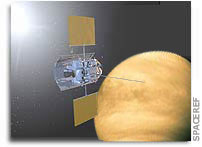NASA MESSENGER Mission News August 3, 2006

Happy Anniversary, MESSENGER!
Today marks the second anniversary of MESSENGER’s launch. “It’s still more than four and a half years to Mercury Orbit Insertion in March 2011, and there are many milestones between now and then,” says Dr. Sean C. Solomon, of the Carnegie Institution of Washington, who leads the mission as principal investigator. “But it’s worth pausing for a few moments today to appreciate how far we’ve come.”
And just how far has the spacecraft traveled since its Aug. 3, 2004, launch from Cape Canaveral Air Force Station, Fla.? Nearly 1.2 billion miles. MESSENGER’s computers have executed 180,271 commands since liftoff, a time interval that includes seven major trajectory correction maneuvers.
“It’s been a busy two years,” says MESSENGER Mission Operations Manager Mark Holdridge, of the Johns Hopkins University Applied Physics Laboratory (APL) in Laurel, Md. “We’ve been by Earth and now we are headed for Venus, another major milestone in this mission.”
MESSENGER team members have been running tests all summer to make sure the spacecraft will operate as intended during the Venus flyby – the first of two swings past the clouded planet –scheduled for Oct. 24, 2006. There will be a 57-minute solar eclipse during that operation. So on Aug. 11, engineers will turn the spacecraft solar panels edge-on to the Sun and discharge the battery, much in the same manner that the power system will function during the Venus flyby, to verify that the system will respond appropriately.
Two weeks later, on Aug. 21, engineers will conduct a “star-poor” region test, pointing the spacecraft’s star tracker in a region of the sky that might be utilized during the Venus operations. Holdridge says a similar test was conducted on July 26, “and we got a positive result from that test; the preliminary results look good.”
All in all, Holdridge says, all systems are functioning very well. “The spacecraft is very healthy, and the team is working hard to make this first flyby of Venus a success!”
For encounter details and graphics associated with the October maneuver, go online to http://messenger.jhuapl.edu/the_mission/MESSENGERTimeline/VenusFlyby1.html.
MESSENGER Engineer Named AIAA Engineer of the Year
APL’s T. Adrian Hill, the fault protection and autonomy lead for MESSENGER, was recently named Engineer of the Year by the Baltimore chapter of the American Institute of Aeronautics and Astronautics (AIAA). Each year, local AIAA chapters present this award to a member who has made significant contributions to the field of engineering. For more information, go online to http://www.jhuapl.edu/newscenter/pressreleases/2006/060623b.asp.
Where is Mercury?
Mercury’s orbit is so close to the Sun that we can only see it from Earth either just before sunrise or just after sunset. For a diagram of the orbits of the inner planets, as they appear today, go online to http://btc.montana.edu/messenger/wheremerc/wheresmerc.php.
MESSENGER (MErcury Surface, Space ENvironment, GEochemistry, and Ranging) is a NASA-sponsored scientific investigation of the planet Mercury, and the first space mission designed to orbit the planet closest to the Sun. The MESSENGER spacecraft launched on Aug. 3, 2004, and after flybys of Earth, Venus and Mercury will start a yearlong study of its target planet in March 2011. Dr. Sean C. Solomon, of the Carnegie Institution of Washington, leads the mission as principal investigator. The Johns Hopkins University Applied Physics Laboratory built and operates the MESSENGER spacecraft and manages the Discovery-class mission for NASA.








